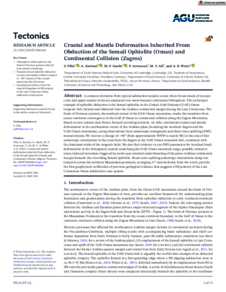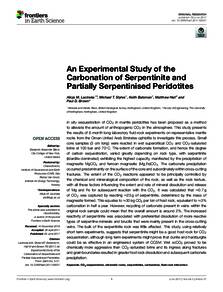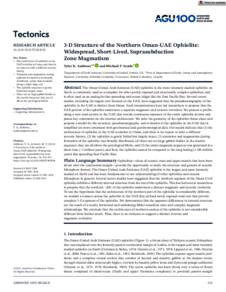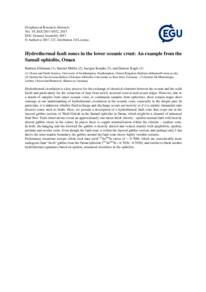Document
Crustal and mantle deformation inherited from obduction of the Semail ophiolite (Oman) and continental collision (Zagros).
Identifier
DOI: 10.1029/2020TC006644
Source
Tectonics. v. 40, 6, e2020TC006644
Contributors
Kaviani, A. , Author
Searle, M. P. , Author
Arroucau, P. , Author
Ali, M. Y. , Author
Watts, A. B., Author
Country
United States.
Publisher
John Wiley and Sons Inc.
Gregorian
2021-06-01
Language
English
English abstract
A common deviation from typical subduction models occurs when thrust sheets of oceanic crust and upper-mantle rocks are emplaced over more buoyant continental lithosphere. The archetypal example of ophiolite obduction is the Semail ophiolite in the United Arab Emirates (UAE)-Oman orogenic belt, formed and obducted onto the Arabian continental margin during the Late Cretaceous. The Strait of Hormuz syntaxis, the northern extent of the UAE-Oman mountains, marks the transition from ocean-continent convergence in the Gulf of Oman to continental collision along the Zagros Mountains. Based on new seismic data from a focused recording network, we infer continental crustal and mantle deformation in the northeastern corner of the Arabian plate (including the southern Zagros and the UAE-Oman mountains), using observations from anisotropic tomography and shear-wave splitting (SWS) measurements. We recover a change of ∼90° (from approximately WNW to nearly NS) in the axis of fast-anisotropic orientations in the crust from the Zagros to the UAE-Oman mountain belt, consistent with the dominant strike of the orogenic belts. We also find evidence in our SWS parameters for localized fossil deformation in the lithospheric mantle underlying the UAE-Oman mountain range, possibly related to stress-induced tectonism triggered by north-east oriented underthrusting of the proto-Arabian continental margin beneath the overriding Semail ophiolite. Shear-wave-splitting anisotropy orientations along two transects across the northern Musandam peninsula, averaging 15° anticlockwise from the north, provide the first geophysical verification of previous geological evidence that suggests a NE polarity of the Late Cretaceous Oman subduction zone system.
ISSN
0278-7407
Category
Journal articles




